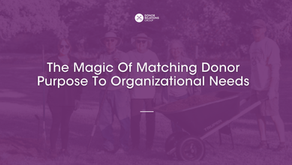Stewardship and Annual Giving: They Go Together Like Peanut Butter and Jelly
- Lynne Wester
- Jun 15, 2023
- 3 min read
Updated: Sep 7, 2023

Why do peanut butter and jelly go together so well? The salt of the peanuts and the sweet jelly blend together perfectly to create a party for your tastebuds. Annual giving and stewardship may not dazzle the tastebuds, but when they work together, they create a robust and engaged donor pipeline.
Most nonprofits rely on annual donors to build out their donor pipeline. Annual donors are the donors who give reliably on a yearly or monthly basis as loyal donors, planned donors, and sometimes ending up as your largest and/or longest giving donors. Your annual giving pipeline is the best place to mine for the future of your giving programs. However, if that’s the case, why do we often overlook this group of donors and provide them with just the bare minimum stewardship, communication, and engagement? Why do we focus our efforts solely on the “top” donors? This focus usually leaves behind donors that are rabid fans, donors who share with their communities the joy of giving to your organization and encourage others to get involved. This oversight is a big one—and one that should be evaluated and corrected immediately.
If you feel like your annual giving stewardship could use some help, here are a few things to consider:
Do you have a dedicated engagement journey or experience for those that give monthly? What about first-time donors? Giving day donors? Giving Tuesday donors, loyal donors, upgraded and lapsed donors?
Does your stewardship or donor relations department partner with your annual giving team to understand their calendar of activity and plan your stewardship programs accordingly?
Do you have a plan in place to share the impact of your giving day, Giving Tuesday, or other mini campaign successes?
Do you have a way to engage and steward donors both digitally and in print based on their preference?
Once you have the answers to these questions, you can start to build out your programs, initiatives, and touch points. This will help retain these donors and provide them with a unique experience that directly relates to their way of giving as well as the behavior you want to enforce. Remember, the goal is to preserve and grow these donors over time to be your most engaged and interested audiences; therefore, the touch points you implement now should be designed with intention and strategy.
Ways to put this to work:
Have donors with no email but have strong digital content to share? Send them a postcard with a QR code or a link to your website.
Is there an inconsistent look and feel to your collateral? Work with annual giving to determine which creative they’re using for each campaign and utilize the same assets for stewardship purposes! This ties the solicitations, recognition, and impact reporting together into one complete package for the recipient.
Lacking efficient video resources? Utilize ThankView or other video services to record custom videos for donors on days of giving or other giving campaigns.
In need of hands on help to thank a lot of donors? Host a thank-a-thon utilizing all advancement staff! Bring in leadership, board members, students and/or recipients of funding to thank donors that contributed throughout the year.
The overarching goal of your job as a donor relations professional is to understand the annual giving calendar and collaborate to create a symbiotic and sustainable program to steward, recognize, and engage the annual giving donor pipeline.
Now that you’ve got a few key tips, go gather that peanut butter and jelly and build out that annual giving stewardship plan – your donors will love it!





